An oscillating turret success
France tried, after the war, to integrate the lessons learned in a new tank doctrine integrating new models, which emphasized firepower and mobility. At the same prewar tactics regarding well-armed fighting reconnaissance armored cars, which could act as anti-tank units as well were also utilized. The German adaptation of high velocity AT guns on various light chassis also indicated some pathways for French engineers to work with. The French Army fully exploited the new promising oscillating turret concept to fit this doctrine.The oscillating turret was basically a way to integrate a larger gun in a smaller turret, allowed by the use of an autoloader, while the lower part of the turret was conventional and still fully traversed. What it meant was that the whole "upper" (oscillating) turret was depressed or elevated as a single block, comprising much of its equipment and personal. In a conventional turret, the gun was elevated and depressed independently inside, the turret providing only traverse. The advantages of such a system were to provide a much smaller -thus lighter- kind of turret, which could mount a bigger gun compared to the size of the chassis, just like tanks-hunters.
The French army designed a whole array of experimental and semi-experimental heavy tanks equipped with heavy guns using oscillating turrets, namely the AMX-50, Somua SM and Lorraine 40t. But this concept only proved successful on large series light vehicles, like the 8-wheeled Panhard EBR and AMX-13. The US Army also experimented with the concept (T69, T54E1, T57) at the same time but ultimately dropped it. The AMX-13 was probably the best known vehicle mounting such a turret, as it was also the most used worldwide, still used by some armies today. It remains the most produced tank by any country in western Europe and by far the biggest French tank production of any time. At the same time it showed the limits of the concept, hard to fit in any conventional tactical structure, not to mention NATO.
Development
The development of a new light tank suited for reconnaissance and flanking protection was stated by the French tank doctrine of the time. It asked for a light and fast tracked vehicle armed with the most effective gun possible. Work started in 1946 and two years later the first prototype was completed. A long line of prototypes led to the production version. The 2A had only 4 roadwheels per side and a trailing idler, while the 2B 5 roadwheels and raised idler, the 2C was the first to mount the FL-10 turret and had two support rollers, while the 2D had 4 support rollers. The next generation was fitted with a 90 mm (3.54 in) gun, introduced on the 2E (1964) also sporting 3 support rollers, followed by the 2F, with 2 support rollers, also the first to test a thermal sleeve.Design of the AMX-13
Turret
Although the chassis was a conventional one, light and sturdy, the very essence of the AMX-13 was its oscillating turret, only rendered possible by using an automatic drum autoloader. This new, original loading system led to the creation of this unusual two-part turret. The lower part was cast and connected to the chassis in a conventional turret ring, while the upper part, cast and welded, was attached to it in such a way that its entire mechanism and attached equipment moved freely inside the fighting compartment. The 75 mm (2.95 in) gun and coaxial machine gun were rigidly attached to the turret top. Rotation and pointing was provided by hydraulic power, traverse to a maximum speed of 30° per second, and vertically to 5° per second. Angles of elevation and depression were +12° and -8°, the elevation angle being limited aft by the recess of the turret roof over the chassis. Turret management was carried out by a gunner and the commander, but the gun did not have a stabilizer. Outside, the turret was equipped with grenade launcher for smoke screens, two banks of three with 12 grenades total. Total weight of the turret without ammunition was 4.5 tons, and comparatively to the gun caliber it was a fair trade.This design allowed the use of a new system with automatic loading arms, consisting of two revolver cylinders, 6 shots each. After the shot gun recoil forces rotated another shell into the barrel bore. Cartridge cases were ejected through a special hatch in the stern of the tower. This system provided an excellent rate - up to 12 rounds per minute. However, a significant drawback is the small ammunition store. It was quickly used up and the tank became virtually unarmed . It was assumed that when the tank remained without shells it left the fight and went to recharge shops. New shells were loaded through hatches in the roof of the tower.
Introduction of an autoloader reduced the crew to just three and therefore allowed a significant reduction in turret size. The tank commander was located left of the gun, and above his position was the commander cupola and hatch, which hinged backwards. The cupola was not traversible, but was fitted with seven prismatic observation prisms L794B protruding at its base, giving full peripheral visibility. Also at the disposal of the commander was a telescopic sight with a range 1.5 to 6 magnification. The gunner was located on the right side and had two prismatic observation devices L794D, with 7.5 magnification and a laser rangefinder TCV 107, providing targeting data both for the gunner and commander. The driver/mechanic was located in the front left, with the engine partly occupying the right side.
Weaponry
Initially, the tank had a 75 mm (2.95 in) rifled gun, and overall 2,000 vehicles of this configuration were built for the French Army. In the course of modernization in 1965, a new 90 mm (3.54 in) rifled gun was mounted on a modified FL-10 turret. This gun had a new muzzle brake and heat insulated housing. Five types of ammunition were used, standard armor-piercing (APFSDS), anti-personal canister, high explosive (HE), cumulative (HEAT) and smoke. 32 shots were stored, 21 inside the turret and 11 in barillets. The tank had two 7.62 mm (0.3 in) machine guns (one coaxial and one in an anti-aircraft mount) fed with 200 round bands, 3600 rounds stored in all.Protection
The AMX-13 protection was quite weak compared to its firepower. It was made of regular bulletproof reinforced steel sheets, with a frontal thickness of about 40 mm (1.57 in), whereas the sides and turret were 20-25 mm (0.79-0.98 om), the rear 15 mm (0.59 in), while the turret top, hull deck and bottom were only 10 mm (0.39 in) thick. Only the frontal armor was able to withstand heavy machine-gun and small autocannon projectiles, the rest of the tank being vulnerable to most projectiles. The AMX-13 was not protected NBC, and night vision was optional.Creusot-Loire attempted to create additional armor panels for the AMX-13. A complete set weight weighted some 650 kg (50 kg for each section). Additional armor could be installed by the crew in the field, on the front and upper side parts of the hull and turret. Fully installed add-on armor provided 20 mm (0.79 in) extra thickness.
Powertrain & wheeltrain
The engine/transmission compartment was at the front-right of the chassis. The motorization was provided by a proven 8-cylinder gasoline liquid-cooled engine, giving 250 hp. The manual transmission comprised 5 forward gears and one reverse, with a steering gear differential. The powertrain being at the front determined the position of drive sprockets, steering wheels with the track tensioning mechanisms behind. The torsion bar suspension comprised the first and last roadwheel with a hydraulic shock absorber each. Each steel track was 350 mm (13.7 in) of wide and contained 85 links, receiving rubber shoes when running on asphalt roads.Performance
The maximum speed was 60 km/h (37 mph) and the fuel tank capacity was 480 liters, reserve sufficient for nearly 400 km (248 mi). The AMX-13 had a ground clearance of 370 mm (15 in), could cross a trench 1.6 m wide (5 ft 3 in), climb a vertical obstacle 0.65 m (26 in) tall or 60° side slope, or ford a 0.6 m deep (24 in) river.Production and exports
The AMX-13 was produced from 1952 to 1964, and under license in Argentina until 1985. It has experienced many upgrades and was exported to 25 countries (out of more than 7000 vehicles produced, half were exported). The AMX-13 chassis was used for conversions including self-propelled artillery and anti-aircraft guns, armored personnel carriers and bridge-carriers, and others.The 1964 version
In 1962, following the planned retirement of the M47 Patton, and before the introduction of the well awaited AMX-30, it was decided to modernize a large portion of the fleet as well as producing a new version of the AMX-13. This massive undertaking comprised no further changes in protection, but increased firepower. First, a new 90 mm (3.54 in) gun was mounted, as the Cockerill Regunning Package. Second, on the front part of the gun base was mounted an SS-11 ATGM system (anti-tank guided missiles). These were wire-guided. Other upgrades delivered by Giat Industries included an Add-on Armour package installed on turret front/sides and a new glacis plate.The 105 mm (4.13 in) version
This version was accompanied by othes improvements and announced at the 1985 Satory Exhibition (near Paris). These included a new diesel engine coupled with a fully automatic transmission, new hydropneumatic suspension for improved cross-country mobility (recognizable by their modified torsion arms and four smaller return rollers above), as well as new, improved storage compartments. Last but not least, the new 105 mm (4.13 in) high velocity gun allowed this model to punch well above its weight. This was the biggest export success of the French tank industry so far.The Modèle 1987
This late production model had significant improvements in firepower, mobility and armor and was solely aimed at the export market. Externally it received a new hull with a modified front/glacis for improved ballistic protection, new hydropneumatic units instead of torsion bars and sand guards. Moreover, the thermal sleeved 105 mm (4.13 in) gun with updated optics and improved laser rangefinder was also part of the package.Prototypes
Later on, another upgrade was attempted when a modified FL-12 turret was equipped with the latest 105 mm (4.13 in) gun paired with a laser rangefinder. The cumulative energy projectile had an initial velocity of 800 m/s and could penetrate 400 mm (15.74 in) of armor.In 1983, an experimental AMX-13 was equipped with a new FL-15 turret with improved observation systems, scopes and laser rangefinders. The automatic transmission was replaced, and it was re-equipped with improved suspension.
Other experiments included an A14 fitted with the German HS-30 turret, AMX-13 fitted with a 105 mm (4.13 in) howitzer barrel (which served as a test base for SPGs), the AMX-13/75 or AMX-13e fielding a short-barreled 75 mm (2.95 in) in a FL-11 turret, the Char AMX-13 with a special 57L/100 gun. Anti-aircraft versions include the twin 20 mm (0.79 in) version in welded turret without bustle (a DCA variant), the "Char 48FCM" for "four guns", or 12T FCM DCA fielding four 20 mm (0.79 in) cannons in a FL-4 turret and the Char 13T DCA de 40 mm Bofors L/70 with the gun in a large faceted turret. Other notable types were the AMX-13 GTI with improved suspension by Krauss-Maffei, the AMX-13 THS which experimented hydrostatic transmission, and two missile versions, the AMX-13 - Rapace 14 MBRL and the AMX-13 HOT (fitted with HOT ATGM launchers).
Variants Including the prototype, there are possibly a hundred variants, including the local built versions, like the Singaporean SM-1. The AMX-13 was built or upgraded over the decades, from 1952 to 1987.
- M24/AMX-13 (avec tourelle Chaffee): temporary solution applied only to a few vehicles, coupling the AMX-13 chassis with the M24 turret.
- AMX 13 DTT: vehicles with the Chaffee turret truncated, serving as driver training tanks.
- AMX-13/FL-10(1) modele 1951: The original version with a high-velocity 75 mm (2.95 in) gun and 2 top rollers, later 4 and revised stowage.
- AMX-13/FL-10(2) modele 1951: Second version with 4 top rollers and revised stowage (both used the Panhard EBR turret).
- AMX-13/FL-11 modele 51: the second production version
- Giat AMX-13: upgrade by Giat Industries.
- LAR-16: Venezualean MBRL (multiple rocket launcher, with 26 120 mm/4.72 in HE projectiles) version.
- Turretless AMX-13: used for driver training (generally former 1952 versions) well into the 90s.
- AMX-13 AD: Venezualean versions fitted with M42 Duster turrets.
- AMX-13/90: FL-12 turret with F3 90 mm (3.54 in) gun, standard 1952 version, also called AMX-13 FL-12.
- AMX-13/90 LRF: Laser rangefinder for the F3 gun (introduction unknown).
- AMX-13/FL-12: or Modèle 1958, incorporating the new 105 mm (4.13 in) gun into the FL-12 turret, used by the Netherlands.
- AMX-13/FL-12 modernized, received a searchlight and FN MAG machine-guns. - AMX-13/FL-15: Dutch FL-12s refitted with an FL-15 Turret. - AMX-13/105: Export version with thermal sleeve and revised hull front.
- AMX-13 avec obusier de 105 mm sous tourelle: 105 mm (4.13 in) howitzer SPG.
- AMX-13 Canon de bitube de 20 mm: or DCA, with twin 20 mm (0.79 in) guns in a welded turret without bustle.
- AMX-D Dépannage Modele 55: 1955 recovery version.
- AMX-13 GTI: semi-experimental version testing a new suspension built by Krauss-Maffei.
- AMX-13 HOT: prototype fitted with HOT ATGM launchers.
- AMX-13 Modèle 1987: late 105 mm production version (4.13 in).
- AMX-13 mod.56: 81 mm (3.19 in) mortar carrier for the Belgian Army.
- AMX-13 mod.56: command post, Belgian Army.
- AMX-13 mod.56: with rear-mounted ENTAC missile launcher, Belgian Army.
- AMX-13 mod.56 VCI: APC fitted with a .30 (7.62 mm) Browning mounted in a CALF38 turret, Belgian Army.
- AMX-13 mod.56: cargo, transport version, Belgian Army.
- AMX-13 PDP: or "Porteur de Pont" prototype scissor-type bridgelayer.
- AMX-13 PDP Modèle 1951: the production version of the above.
- AMX-13 PDP Modèle F1: improved bridgelayer version.
- AMX-13S SAE: major standard AMX-13 upgrade.
- AMX-13 SM1: was the Singaporean Armed Forces modernized version.
- AMX-13 T75: the standard missile-equipped version, with SS-11 ATGM launchers, guided by wire.
- AMX-13 T75/TCA: received an electronic guidance system for the SS-11 missiles.
- AMX-13 THS: prototype fitted with a new hydrostatic transmission.
- AMX-13V CLI: upgraded AMX-13/90, Venezuelan Army.
- AMX-13 VCPC: upgraded AMX-13 VCI, Venezuelan Army.
- AMX-40 DCA: air defense vehicle using a single 40 mm (1.57 in) gun.
- AMX-113: the Argentinian upgrade version.
- AMX-105A: or AMX Mk. 61. Automoteur de 105 du AMX-13 en casemate, or howitzer SPG version.
- AMX-105B: or AMX Mk. 62, 105 mm (4.13 in) turreted SPG, and 63 (same with a machine-gun cupola fitted to turret).
- AMX-155: or AMX Mk. F3, or "Obusier de 155mm sur affut automoteur AMX 13 T", standard 155 mm (6.1 in) SPG version.
- AMX-DCA: the standard SPAAG version armed with twin 30 mm (1.18 in) autocannons.
- AMX-DCA 30: same as above upgraded with a radar.
- AMX DOZER: turretless dozer blade equipped version.
- AMX-GWT: Dutch army version of the VCTB.
- AMX-LT: artillery fire control vehicle based on the VTT.
- AMX-PC: command post version based on the VTT.
- AMX-VCA: support vehicle for the AMX-155 based on the VTT.
- AMX-VCTB: ambulance version based on the VTT.
- AMX-VTP: the original APC version with a 20 mm (0.79 in) autocannon in turret.
- AMX-VTT/VCI: modernized APC version equipped with either a 12.7 mm (0.5 in) or 7.62 mm (0.3 in) MAC machine-guns.
- AMX-VTT Cargo: specialized cargo version of the VTT.
- AMX-VTT/NA2: this version received an ATGM launcher.
- AMX-VTT PADTA: air surveillance radar specialized VTT.
- AMX-VTT RATAC: ground surveillance radar vehicle based on the VTT.
- AMX-VTT ROLAND: experimental Roland SPAAML VTT-based vehicle.
- AMX-VTT TOW: Dutch Army version of the VTT with TOW launcher placed on the cupola.
- AMX-VTT Modele 1987: modernized version with better mobility, fire system and other improvements.
- AMX-VTT/Minotaur Mine System: scatterable mine-laying system place on the rear of a VTT.
- AMX Mk 61: Dutch Army, cal 0.30 (7.62 mm) Browning machine gun fitted in the commander cupola.
- AMX-13 57L/100: prototype with a new 100 mm (3.94 in) gun.
- AMX 12 FCM DCA: quad 20 mm (0.79 in) autocannon version in the FL-4 turret.
- AMX13/Cockerill: 90 mm (3.54 in) Regunning Package upgrade.
- DNC-1 "Grua": locally modified Modele 1955 dépannage, Mexican army.
- Giat Add-on armor package: installed on turret front/sides & glacis plate, upgrade.
- Leichter Panzer 51: Swiss Army version
- NIMDA Upgrade: retrofit package, Israel.
- M4 Sherman/AMX-13 turret: an upgrade only used by Egypt (some were captured later by Tsahal in 1967).
Main derivatives
AMX VCI (former VTT)
Which stands for "Mechanized Infantry Vehicle" (in French), was produced in 1957. This was a completely new superstructure built above the light chassis, with a machine-gunner above the driver compartment. He fired a 7.9 mm (0.31 in), cal.50 (12.7 mm) and culminating with a tele-operated 20 mm (0.79 in) gun turret. The VCI could carry a platoon (ten men), but was quite cramped. More than 3000 were built. It was exported to twelve other countries and derived into twenty-six versions.AMX 105 SPG
The standard 105 mm (4.13 mm) self-propelled howitzer of the French army from 1955, until it was replaced by the version derived from the AMX-30 chassis. The first version had a fixed turret, later had a traversing one. Variants were the Mk. 61 to Mk. 64, also widely exported. 550 were produced in all.AMX 155 SPG
This was the 155 mm (6.1 in) self-propelled gun F3, also called "Obusier de 155 mm sur affut automoteur AMX-13 T", meant to replace the US-built M41 Gorilla in the French army in 1952. Due to the weight and size of the gun, there was no turret, the crew was operated from behind, unprotected. A support vehicle was needed to carry them, plus the ammo. But it was and remains the smallest and lightest of this kind ever built. It was produced to around 600 vehicles and exported to nine other nations. Decommissioned in 1997 in France.AMX DCA
Self-propelled anti-aircraft gun DCA. Two main versions and several prototypes were tested. The AMX-12 served as a testbed, as the AMX 12 FCM DCA, with a quad 20 mm (0.79 in) (same as for the US. the M3 half-track version). The initial version had a single 40 mm (1.57 in) Bofors gun (modernized) inside a rotating welded turret, with flat faces. Also called AMX-40, it seems to have been produced in limited numbers. The main version was the AMX DCA bitube de 30 mm SPAAG, with twin 30 mm (1.18 in) guns in a cast turret, which received a guidance radar as an upgrade. They were phased out and replaced by AMX-30 based versions in the eighties.AMX Bridgelayer
Also called PDP for "Poseur De Pont" (French for bridgelayer), this version was developed and issued to units in 1955 (it was also called "Mle 55"). This was a scissor-type bridgelayer, with a practical span of 12 m (13 yards) when deployed.Operators/Operational records
France
French units absorbed the bulk of the 75 mm (2.95 in) (first model) production, with some 3000 vehicles. It was spread among regular division, then equipped with M47 and later M48 Pattons, as screening units. Their tactical use imposed four-strong AMX-13 platoons divided in two sections, two scout sections of infantry and scout vehicles, plus the ammo truck and a command vehicle. The recce section located and determined the nature of enemy forces, then searched for a firing position and engaged the enemy, followed by the second section while the first retired for reloading. Both alternated until the bulk of medium tanks arrived.When the AMX-30 entered service in the late sixties, the tactical use of this vehicle began to change. The AMX-13 saw action in the decolonization war of Algeria (1954-1962), in a limited way due to the absence of opposition and the rough nature of the Algerian countryside from where the Fellagas (Algerian nationalist guerrillas) operated. When the AMX-13 was upgraded to the 90 mm/SS-11 (3.54 in) system, its role as an active screening force became more intertwined with the normal operations of the AMX-30, which were faster than the former US Tanks in operations. These relatively cheap vehicles were more often committed in foreign theaters of operation, mainly in Africa. It also began a second-hand carrier in the hands of well-equipped mercenary forces involved in various operation in Africa in the seventies and eighties. After 1985, the AMX-13 was gradually decommissioned and put in reserve. However Nexter (former Giat Industries) still maintained update kits parts for various export customers until the late 1990s. The AMX-13 was not an overall success though. The revolver loading system imposed frequent reloading operations on the outside, making the crew easy targets. The gun was accurate and good enough for WWII era mediums, but showed deficiencies against modern MBTs, partly compensated by missiles. Elevation was limited by the turret design, and maintenance was not easy. The protection was so light it forbade any engagements against MBTs and modern mediums on open fields, requiring instead well-prepared ambush camouflaged positions, helped by its tiny silhouette and surrounding vegetation. Another severe drawback was its complete lack of NBC protection. But it was nevertheless cheap, adaptable, fast, and largely punched above its weight.
The Netherlands
This was the first country to operate the 105 mm (4.13 in) version outside France (modele 1958), initially with the FL-12 standard turret, then upgraded with a laser rangefinder and thermal sleeve gun. This was the AMX-13/FL-12 modernized with searchlight and FN MAG machine-guns. Then the AMX-13/FL-15 was a Dutch FL-12 version refitted with an FL-15 turret, kept in service until the late 80s. VTTs were also largely employed and knew local variants. In all, Holland had 131 AMX-13s in service for its light tank battalions.Switzerland
The Swiss army introduced the AMX-13 as the Leichter Panzer 51, with a few local modifications. 200 were received between 1952 and 1954, and equipped light tanks battalions until 1961. They were gradually phased out in the 1980s. The Swiss army also extensively tested four 105 mm (4.13 in) howitzer vehicles (AMX-105B), but declined any purchase.Other European users
The Belgian army purchased an unknown numbers of AMX-13 and AMX-VTT APC versions, which knew two local variants. Austria also purchased one AMX-13/105 for trials. The SK-105 Kurassier was derived from it, but with many local modifications performed by Saurer-Werk. It was ready by 1967 and was the second most-produced oscillating turret tank in Europe, with over 700 delivered by the seventies. It was also exported to Argentina, Bolivia, Botswana, Brasil, Morocco and Tunisia.Israel
Before France decided to place an embargo on weapon deliveries to Israel, the Tsahal acquired and operated some 400 AMX-13s, then its first modern light tanks, received just before the Sinai campaign (1956). They complemented the heavier British Centurions of the first generation. They fought in the 1953 Suez canal offensive, later in 1956 but also all along the 1967 war, where three AMX-13 battalions fought actively. Their battle records (notably the 4th Mechanized Bigade) showed that they did have some troubles with Syrian/Egyptian T-54/55s and M48s, both on the Jordanian front and the Golan Heights. They saw limited use in 1973. By the eighties, the AMX-13s grew obsolescent and IDF developed a solution, both for his own needs and the export market (Singapore).This was the NIMDA Upgrade Package. Performed by the Israeli company NIMDA, a complete retrofit package was developed, including a new Detroit Diesel 6V-53T engine which produced 275 hp at 2800 rpm, coupled to a NIMDA N303 automatic transmission with improved automation which included a dry type, mechanically actuated clutch and cooling system, computerized Elbit LANCELOT Fire Control System dramatically improving the first round hit probability, which could be adapted to either the 75, 90 or 105 mm (2.95, 3.54 and 4.13 in) versions. It also included additional armor protection and a fire/explosion detection and suppression system. All former IDF non-modernized AMX-13s had been sold to Singapore by 1969, and those modernized also in the 1990\'s.
Other African/Middle East users
Kuwait seems to have receive some AMX-13s, but no information is available about these. Lebanon also received 35 in 1976. They saw extensive service during the Lebanese war against the Hezbollah in the hand of various armed groups in and outside Beirut. Egypt received some, and also upgraded ageing M4 Shermans with AMX-13 105 mm (4.13 in) turrets, later captured and reused by the IDF. Morocco also made use of some, later discarded, while 4 were captured by insurgents of the Sahrawi Arab Democratic Republic and POLISARIO combatants in Western Sahara. Morocco swapped its AMX-13s for more advanced Austrian Kurassiers (still in service). Algeria also seemingly captured a few AMX-13 during its Independence war. Tunisia also purchased some AMX-13s during the seventies.Asian AMX-13s
Indonesia is still using 500 AMX-13s of the early 105 mm (4.13 in) version. Little is known however about the extent or nature of their modernization, but their storage facilities were apparently completely overhauled on the same lines as the Singaporean SM-1. They are mounting a standard NATO 7.62 mm (0.3 in) machine-gun aside the commander cupola. Some are retired or in reserve. Singapore is the other user of the AMX-13/105, former IDF vehicles modernized twice, first with the NIMDA package, then with a local set of additional modifications called SM-1. Other unmodified AMX-13/75 FL-11s were in use before being converted to the SM-1 package. The latter includes a modernized communications set, new diesel engine, improved transmission and suspension, a more recent laser range-finder and upgraded ST Kinetics night vision system. Nepal and Cambodia apparently also operate a few AMX-13s. India once received up to 75 vehicles (two squadrons of 75 AMX-13/75s), well-used during the Indo-Pakistani War of 1965. At the Battle of Asal Uttar they performed relatively well against Pakistani M47/48, but were wiped out at the Battle of Chawinda against M48s. A single squadron was again active in the 1971 war.South American AMX-13s
The biggest user of the main AMX-13 variant, the VCI SPG, is Mexico, with 409 still in use. Ecuador also operates some 105 AMX-13s, followed by Peru with 210 AMX-13/105s, the export version with thermal sleeve and laser rangefinder. The Peruvian army also tried the AMX-13PA5 Escorpion and AMX-13PA8 Escorpion-2, well-modernized versions, and the derivative 155 mm (6.1 in) howitzer version. Chile also operated 12 of these AMX F3 155 mm (6.1 in) SPGs and Argentina 60, now in reserve. The Dominican Republic also used 15 vehicles. Guatemala and El Salvador also apparently received twelve AMX-13s each, now retired.Venezuelan AMX-13s
36 AMX-13/76 were purchased in the mid-1950s, followed by an additional 31 of the 90 mm (3.54 in) version, later overhauled and modernized. These were stripped down and refurbished with a Detroit Diesel Model 6V-53T engine coupled to a Borg Warner three-speed fully automatic transmission, torque converter, Chausson air-water/oil cooler alternator, 200 A generator and NATO 6TN batteries. The suspension comprised new hydropneumatic units. The new Soptac 18-02 fire control system incorporated the M213 day sight and TCV-107 laser range-finder. These vehicles are visually identified by their gun equipped with thermal sleeve and large mud/sand guards and side skirts.Links
The AMX-13 on WikipediaThe AMX-13 on JED site
The AMX-13 on chars-francais.net (French)
On Militarist.ru (In Russian)
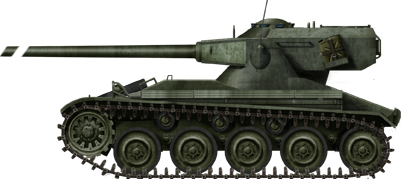
AMX-12T, a prototype forerunner of the AMX-13.
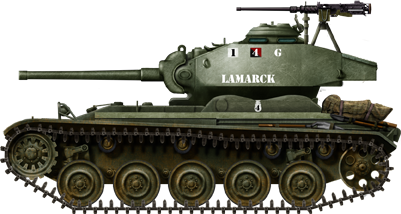
Initial production AMX-13, fitted with a M24 Chaffee turret
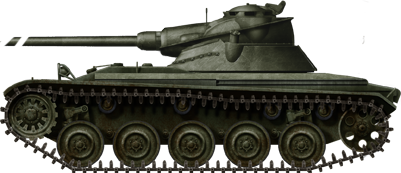
AMX-13/FL-11 or modèle 51. The turret was shared with the Panhard EBR. This second version had 4 top rollers (instead of two) and revised stowage.
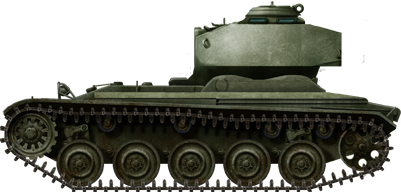
AMX-13 DTT driver training tank.
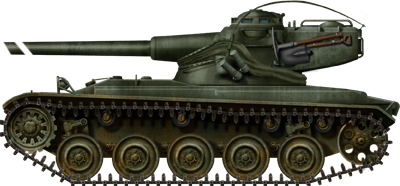
AMX-13/75 Modèle 52, High Definition illustration.
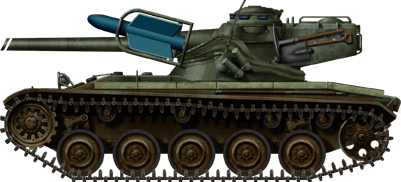
AMX-13 T75 fitted with four SS.11 ATGM launchers.

AMX-13/90 SS11, 1968.
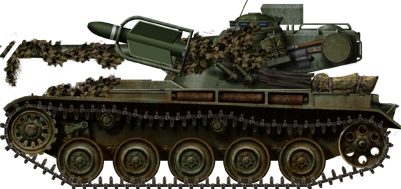
AMX-13 T75/TCA (electronic guidance system for the missiles) in 1969.

AMX-13/90 Modèle 52, FL-10 turret refitted with the F3 90 mm (3.54 in) gun, 1955.
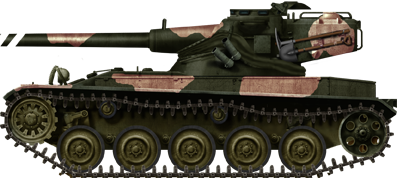
Former indian army\'s AMX-13/75 captured by Pakistani forces during the Indo-Pakistani war of 1965.
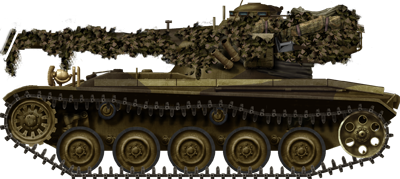
Camoufaged French AMX-13/90 with thermal sleeves operating in Africa, 1970s.
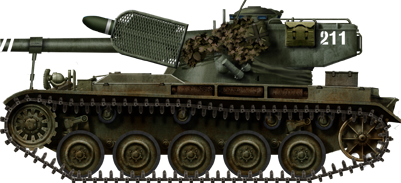
AMX-13/90 Modèle 65, with SS.11 ATGM launchers.
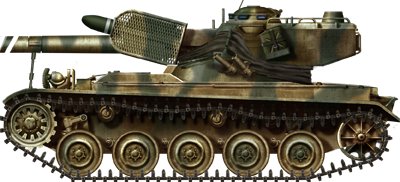
AMX-13/90 LRF (equipped with a laser rangefinder), Djibouti, 1980s.

AMX-13/90 with thermal sleeve, 1980.
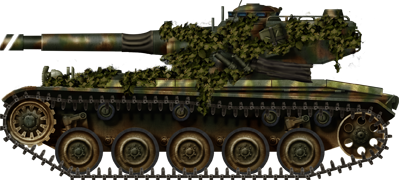
AMX-13/90 wih thermal sleeves, fully camouflaged.
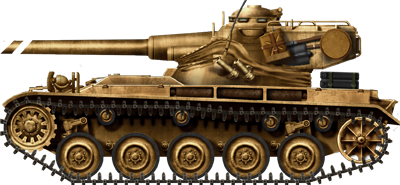
AMX 13 FL-12 Mle 58, the original 105 mm (4.13 in) version, here stationed in Africa.
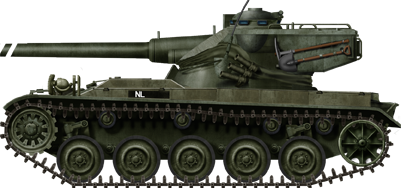
Dutch AMX 13/105, "B16" from the 103rd reconnaissance batallion (Cavalerie Verkenningseskadron), 1985.
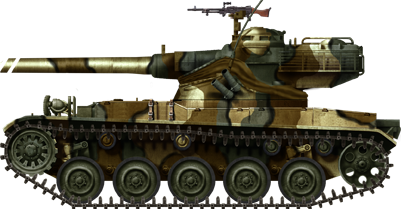
AMX-13/105 of the Indonesian army.
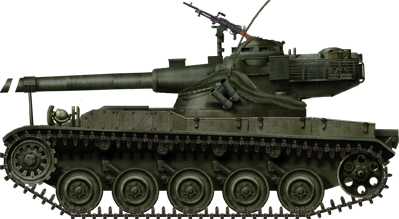
AMX-13/105 SM-1 (Singapore Modernized 1).
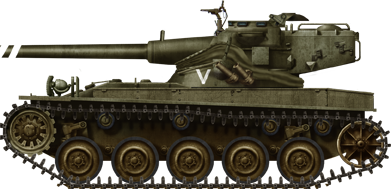
AMX-13/75 of the IDF, 1967\'s Six-Day War.
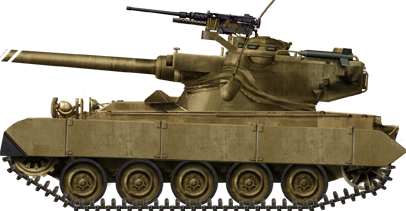
Giat Industries\' modernized AMX-13, 1987 version, with thermal sleeve 105 mm (4.13 in), improved suspension, laser rangefinder, improved optics and targeting system, new engine and transmission, revised storage, mud guards, side skirts, cal.30 (7.62 mm) and cal.50 (12.7 mm) machine-guns plus four AT missiles.
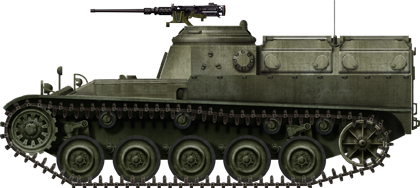
AMX-VCI (VTT) armored personal carrier.
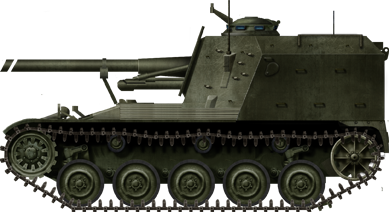
AMX-105A, Automoteur de 105 du AMX-13 en casemate or mle.50, early fixed casemate version, 1955. This version was also called AMX Mk.61 for export. The Mk.61 was the Dutch version. A second one (Mk.62 or AMX 105B) introduced a traversible turret in 1958.
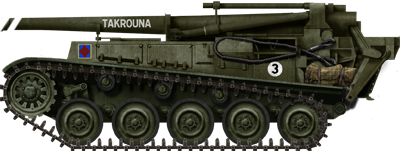
AMX-155 SPG canon de 155 mm (6.1 in) mle F3 automouvant, 1st Marine Artillery Regiment, 1st Armored Division, Melun, 1972.
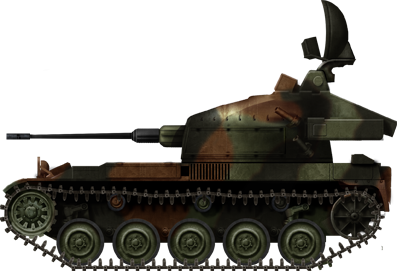
AMX DCA bitube 30 mm (1.18 in) SPAAG, in its modernized version, 1980s.
AMX-13 Gallery
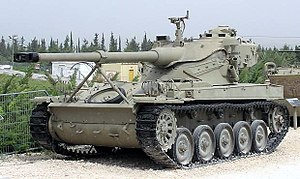
A former IDF AMX-13/75 now exposed at the Latrun Museum. (Wikipedia Commons)


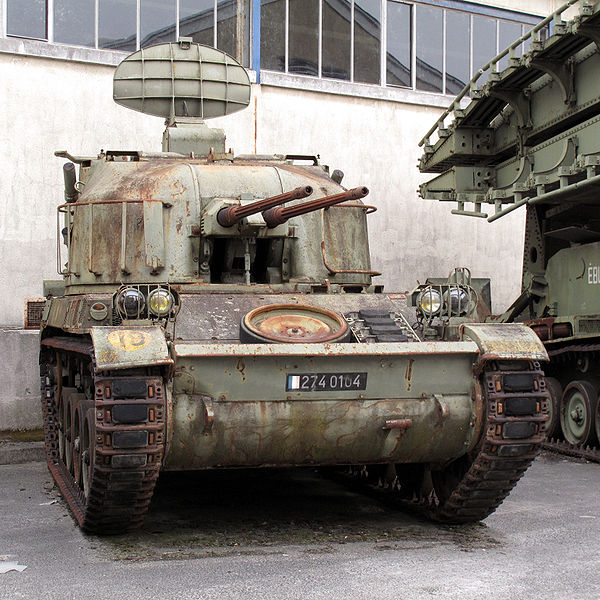

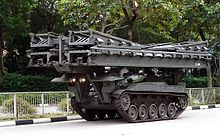



AMX-13 (1952 75 mm version) |
|
| Dimensions (l-w-h) | 6.3 x 2.5 x 2.3 m (20.6 x 8.2 x 7.5 ft) |
| Total weight, battle ready | 15 tons |
| Crew | 3 (driver, co-driver/machine-gunner, commander/gunner) |
| Propulsion | Renault gasoline, 8-cylinder water-cooled 250 hp |
| Suspension | Torsion arms |
| Maximum speed | 60 km/h (40 mph) |
| Range (road) | 400 km (250 mi) |
| Armament | 75 mm (2.95 in) SA50 with 12 rounds (barillet)
2 x 7.5 mm (0.295 in) MAC machine-guns, 3600 rounds |
| Armor | Hull nose and turret 40 mm (1.57 in), sides 20 mm (0.79 in), bottom 15 mm (0.59 in), rooftop 10 mm (0.39 in) |
| Production (French army only) | 4300 |

Cold War Tanks


































Cold war tanks posters

Cold War Main Battle Tanks

Cold War Soviet Army
Museums, Movies, Books & Games
The Tanks and Armor in pop culture
Tanks and armored vehicles in general are only really grasped when seen first person: The mass, the scale, it's all there. Explore also the way tanks were covered in the movie industry, in books and in video games.Movies:
Best tanks movie on warhistoryonline.com
On imdb.com
On bestsimilar.com/
miltours.com
liveabout.com/
watchmojo.com
Video Games:
pcgamesn.com
historyhit.com
levvvel.com
vg247.com/best-tank-games
mmobomb.com/
alienwarearena.com

